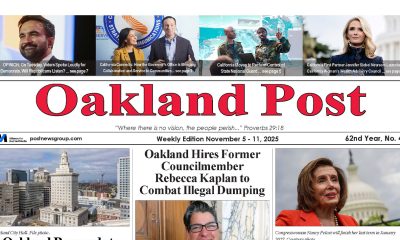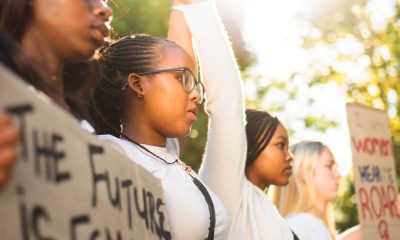#NNPA BlackPress
House Passes $2 Trillion Stimulus Package Deal
NNPA NEWSWIRE — Earlier, several civil rights organizations noted watching with vigilance as Senate negotiations and, later, voting in both chambers took place. “We know that when the economy goes into decline, people of color always bear the brunt,” said Teresa Candori, communications director for the National Urban League. “We will be fighting to make sure the most vulnerable communities are not an afterthought.”
By Stacy M. Brown, NNPA Newswire Senior Correspondent
@StacyBrownMedia
The $2 trillion stimulus deal reached earlier by the Senate, was finally passed by the House on Friday, March 27.
President Trump is expected to immediately sign the massive legislation that promises to provide a much-needed shot in the arm for working and unemployed individuals, and small and big businesses.
The deal includes approximately $367 billion for small business loans administered through the Small Business Administration.
It also includes direct payouts to most Americans and more money and an extension of unemployment benefits.
While the bipartisan measure unanimously passed in the Senate, at least two Republican congressmen opposed the bill.
Colorado Rep. Ken Buck argued that he didn’t want “the cure to be worse than the problem itself.” Buck objected to the inclusion in the package of $75 million for public broadcasting, $50 million for museums and libraries, and $25 million for the Kennedy Center.
Earlier, Rep. Matt Gaetz (R-Fla.) blasted Senate members for including $13 million for Howard University, a historically black college.
Rep. Thomas Massie (R-Kentucky) attempted to force a full yes or no vote that reportedly irritated House members who agreed to do a voice vote in which members were not required to attend in person and risk personal safety in light of the spreading coronavirus.
Earlier, several civil rights organizations noted watching with vigilance as Senate negotiations and, later, voting in both chambers took place.
“We know that when the economy goes into decline, people of color always bear the brunt,” said Teresa Candori, communications director for the National Urban League.
“We will be fighting to make sure the most vulnerable communities are not an afterthought.”
The coronavirus is “an equal-opportunity pandemic,” stated Melanie Campbell, president of the National Coalition on Black Civic Participation.
“If you think about (Hurricane) Katrina, if you think about other catastrophes, a lot of times, bailouts ended up taking care of the top, and then it trickles down to the people,” Campbell said.
“Our federal government has to be bold about responses as this is an ever-evolving pandemic that can become a real catastrophe for people’s daily lives.”
Many said they’re reminded that the household wealth of communities of color declined during the 2008 recession.
They said those losses never recovered, and it’s led to fears that minorities will again suffer a severe and long-term hit as the nation battles COVID-19 and whatever the aftermath might present.
The agreed upon stimulus package includes one-time direct payments of $1,200 per adult who made $75,000 or less in 2019 and $2,400 for couples who made less than $150,000.
An additional $500 will be added for each child.
If individuals haven’t filed 2019 taxes, the payouts will be based on their 2018 returns.
The payments will phase out at a rate of $5 per every additional $100 in income over $75,000 in adjusted gross income for single adults, $112,500 for heads of household, and $150,000 for married couples filing jointly.
The checks would be directly deposited into bank accounts if you included direct deposit information on your tax form. If you did not, your check would be mailed.
Lawmakers and President Trump have said they want the checks mailed by April 6. Still, because the Internal Revenue Service has reduced staff at all of its locations because of the coronavirus, many believe the checks may not go out until May.
Residents are not expected to have to fill out any forms or call the IRS because the government will automatically send payment based on information culled from a 2018 or 2019 tax return.
Meanwhile, with unemployment rates expected to approach 20 percent – and as much as 30 percent among minorities, Senate Minority Leader Chuck Schumer (D-N.Y.) emphasized the need for more available benefits and a more extended period.
Under the stimulus deal, the federal government adds $600 per week to the state benefits jobless workers currently receive. The deal adds four months to the 26-week limit that benefits are paid.
“It’s unemployment insurance on steroids,” Schumer proclaimed. “But, and most importantly, the federal government will pay your salary, your full salary, for now, four months.”
Michele Evermore, the senior policy analyst at the National Employment Law Project, called the inclusion of the new unemployment provision, “unprecedented.”
“Because this situation is so different, we have to break all the rules,” Evermore stated.
The new stimulus also adds a “pandemic unemployment assistance program,” which provides jobless benefits to independent contractors, gig economy workers, and the self-employed, who typically don’t qualify for such assistance.
For small businesses, the stimulus means they will get $367 billion to keep making payroll even while workers are required to stay at home.
Companies with 500 employees or less that keep paychecks steady could get up to $10 million each in forgivable small business loans.
Federally guaranteed loans will provide eight weeks of assistance for qualifying employers who maintain payroll. Those who meet requirements would have costs such as utilities, mortgage interest, and rent forgiven. Individuals can also defer payment of their 2020 payroll taxes for up to two years, and employers are allowed to cut workers’ hours but not lay them off.
Those workers are then eligible for some unemployment benefits.
Businesses can apply for COVID-19 relief through the stimulus by visiting, www.sba.gov/coronavirus. The website is expected to become operational soon.
#NNPA BlackPress
LIHEAP Funds Released After Weeks of Delay as States and the District Rush to Protect Households from the Cold
BLACKPRESSUSA NEWSWIRE — The federal government has released $3.6 billion in home heating assistance after a delay that left states preparing for the start of winter without the program’s annual funding.

By Stacy M. Brown
Black Press USA Senior National Correspondent
The federal government has released $3.6 billion in home heating assistance after a delay that left states preparing for the start of winter without the program’s annual funding. The Low-Income Home Energy Assistance Program, known as LIHEAP, helps eligible households pay heating and cooling bills. The release follows a shutdown that stretched 43 days and pushed agencies across the country to warn families of possible disruptions.
State officials in Minnesota, Kansas, New York, and Pennsylvania had already issued alerts that the delay could slow the processing of applications or force families to wait until December for help. In Pennsylvania, more than 300,000 households depend on the program each year. Minnesota officials noted that older adults, young children, and people with disabilities face the highest risk as temperatures fall.
The delay also raised concerns among advocates who track household debt tied to rising utility costs. National Energy Assistance Directors Association Executive Director Mark Wolfe said the funds were “essential and long overdue” and added that high arrearages and increased energy prices have strained families seeking help.
Some states faced additional pressure when other services were affected by the shutdown. According to data reviewed by national energy advocates, roughly 68 percent of LIHEAP households also receive nutrition assistance, and the freeze in multiple programs increased the financial burden on low-income residents. Wolfe said families were placed in “an even more precarious situation than usual” as the shutdown stretched into November.
In Maryland, lawmakers urged the Trump administration to release funds after the state recorded its first cold-related death of the season. The Maryland Department of Health reported that a man in his 30s was found outdoors in Frederick County when temperatures dropped. Last winter, the state documented 75 cold-related deaths, the highest number in five years. Rep Kweisi Mfume joined more than 100 House members calling for immediate federal action and said LIHEAP “is not a luxury” for the 100,000 Maryland households that rely on it. He added that seniors and veterans would be placed at risk if the program remained stalled.
Maryland Gov. Wes Moore used $10.1 million in state funds to keep benefits moving, but noted that states cannot routinely replace federal dollars. His administration said families that rely on medical equipment requiring electricity are particularly vulnerable.
The District of Columbia has already mapped out its FY26 LIHEAP structure in documents filed with the federal government. The District’s plan shows that heating assistance, cooling assistance, weatherization, and year-round crisis assistance operate from October 1 through September 30. The District allocates 50 percent of its LIHEAP funds to heating assistance, 10 percent to cooling, 13 percent to year-round crisis assistance, 15 percent to weatherization, and 10 percent to administrative costs. Two percent is used for services that help residents reduce energy needs, including education on reading utility bills and identifying energy waste.
The District’s plan lists a minimum LIHEAP benefit of $200 and a maximum of $1,800 for both heating and cooling assistance. Crisis benefits are provided separately and may reach up to $500 when needed to resolve an emergency. The plan states that a household is considered in crisis if it has been disconnected from energy service, if heating oil is at 5 percent or less of capacity, or if the household has at least $200 owed after the regular benefit is applied.
The District’s filing notes that LIHEAP staff conduct outreach through community meetings, senior housing sites, Advisory Neighborhood Commissions, social media, posters, and mass mailings. The plan confirms that LIHEAP applicants can apply in person, by mail, by email, or through a mobile-friendly online application and that physically disabled residents may request in-home visits.
As agencies nationwide begin distributing the newly released funds, states continue working through large volumes of applications. Wolfe said LIHEAP administrators “have been notified that the award letters have gone out and the states can begin to draw down the funds.”
#NNPA BlackPress
Seven Steps to Help Your Child Build Meaningful Connections
BLACKPRESSUSA NEWSWIRE — Swinging side by side with a friend on the playground. Sharing chalk over bright, colorful sidewalk drawings. Hiding behind a tree during a spirited game of hide-and-seek. These simple moments between children may seem small, but they matter more than we think

By Niyoka McCoy, Ed.D., Chief Learning Officer, Stride/K12
Swinging side by side with a friend on the playground. Sharing chalk over bright, colorful sidewalk drawings. Hiding behind a tree during a spirited game of hide-and-seek. These simple moments between children may seem small, but they matter more than we think: They lay the foundation for some of life’s most important skills.
Through everyday play, young children begin learning essential social and emotional skills like sharing, resolving conflicts, showing empathy, and managing their emotions. These social skills help shape emotional growth and set kids up for long-term success. Socialization in early childhood isn’t just a “nice-to-have”—it’s essential for development.
Yet today, many young children who haven’t yet started school aren’t getting enough consistent, meaningful interaction with peers. Research shows that there’s a decline in active free play and peer socialization when compared to previous generations.
There are many reasons for this. Children who are home with a parent during the day may spend most of their time with adults, limiting opportunities for peer play. Those in daycare or preschool may have restricted free play, and large classrooms can reduce supervision and social coaching. Some children live in rural areas, are homebound due to illness, have full schedules, or rely on screens to fill their playtime. And for some families, finding other families with young children to connect with isn’t easy.
While these challenges can feel significant, opportunities for connection still exist in every community. Families can take simple steps to help children build friendships, create a sense of belonging, and strengthen social skills. Here are some ideas to get started:
- Storytime sessions at libraries or local bookstores
- Community offerings such as parent-child workshops, art, music, gymnastics, swimming, or sports programs
- Weekly events at children’s museums, which may include art projects, music workshops, or science experiments
- Outdoor exploration, where kids can play with peers
- Local parenting groups that organize playdates and group activities
- Volunteer opportunities where children can participate, such as pet adoption events or packing meals at a food bank
- Classes for kids at local businesses, including hardware, grocery, or craft stores
Some of these community activities are free or low-cost and give kids the chance to build friendships and practice social skills. Parents can also model positive social behavior by interacting with other parents and encouraging their children to play with their peers.
These may seem like small moments of connection, but they can have a powerful impact. Every time your child shares a toy, plays make-believe with peers, or races a friend down the slide, they’re not just playing—they’re learning the skills that build confidence, empathy, and lasting friendships. And it’s good for you, too. Creating intentional opportunities for play also helps you strengthen your own network of parents who can support one another as your children grow together.
#NNPA BlackPress
Seven Steps to Help Your Child Build Meaningful Connections
BLACKPRESSUSA NEWSWIRE — Swinging side by side with a friend on the playground. Sharing chalk over bright, colorful sidewalk drawings. Hiding behind a tree during a spirited game of hide-and-seek. These simple moments between children may seem small, but they matter more than we think

By Niyoka McCoy, Ed.D., Chief Learning Officer, Stride/K12
Swinging side by side with a friend on the playground. Sharing chalk over bright, colorful sidewalk drawings. Hiding behind a tree during a spirited game of hide-and-seek. These simple moments between children may seem small, but they matter more than we think: They lay the foundation for some of life’s most important skills.
Through everyday play, young children begin learning essential social and emotional skills like sharing, resolving conflicts, showing empathy, and managing their emotions. These social skills help shape emotional growth and set kids up for long-term success. Socialization in early childhood isn’t just a “nice-to-have”—it’s essential for development.
Yet today, many young children who haven’t yet started school aren’t getting enough consistent, meaningful interaction with peers. Research shows that there’s a decline in active free play and peer socialization when compared to previous generations.
There are many reasons for this. Children who are home with a parent during the day may spend most of their time with adults, limiting opportunities for peer play. Those in daycare or preschool may have restricted free play, and large classrooms can reduce supervision and social coaching. Some children live in rural areas, are homebound due to illness, have full schedules, or rely on screens to fill their playtime. And for some families, finding other families with young children to connect with isn’t easy.
While these challenges can feel significant, opportunities for connection still exist in every community. Families can take simple steps to help children build friendships, create a sense of belonging, and strengthen social skills. Here are some ideas to get started:
- Storytime sessions at libraries or local bookstores
- Community offerings such as parent-child workshops, art, music, gymnastics, swimming, or sports programs
- Weekly events at children’s museums, which may include art projects, music workshops, or science experiments
- Outdoor exploration, where kids can play with peers
- Local parenting groups that organize playdates and group activities
- Volunteer opportunities where children can participate, such as pet adoption events or packing meals at a food bank
- Classes for kids at local businesses, including hardware, grocery, or craft stores
Some of these community activities are free or low-cost and give kids the chance to build friendships and practice social skills. Parents can also model positive social behavior by interacting with other parents and encouraging their children to play with their peers.
These may seem like small moments of connection, but they can have a powerful impact. Every time your child shares a toy, plays make-believe with peers, or races a friend down the slide, they’re not just playing—they’re learning the skills that build confidence, empathy, and lasting friendships. And it’s good for you, too. Creating intentional opportunities for play also helps you strengthen your own network of parents who can support one another as your children grow together.
-

 Activism4 weeks ago
Activism4 weeks agoOakland Post: Week of November 5 – 11, 2025
-

 Activism3 weeks ago
Activism3 weeks agoOakland Post: Week of November 12 – 18, 2025
-

 Activism2 weeks ago
Activism2 weeks agoIN MEMORIAM: William ‘Bill’ Patterson, 94
-

 Activism3 weeks ago
Activism3 weeks agoHow Charles R. Drew University Navigated More Than $20 Million in Fed Cuts – Still Prioritizing Students and Community Health
-

 #NNPA BlackPress3 weeks ago
#NNPA BlackPress3 weeks agoThe Perfumed Hand of Hypocrisy: Trump Hosted Former Terror Suspect While America Condemns a Muslim Mayor
-

 #NNPA BlackPress3 weeks ago
#NNPA BlackPress3 weeks agoProtecting Pedophiles: The GOP’s Warped Crusade Against Its Own Lies
-

 Bay Area3 weeks ago
Bay Area3 weeks agoNo Justice in the Justice System
-

 #NNPA BlackPress4 weeks ago
#NNPA BlackPress4 weeks ago2026 Subaru Forester Wilderness Review: Everyday SUV With Extra Confidence






















































Pingback: Panafricanmedia Networks